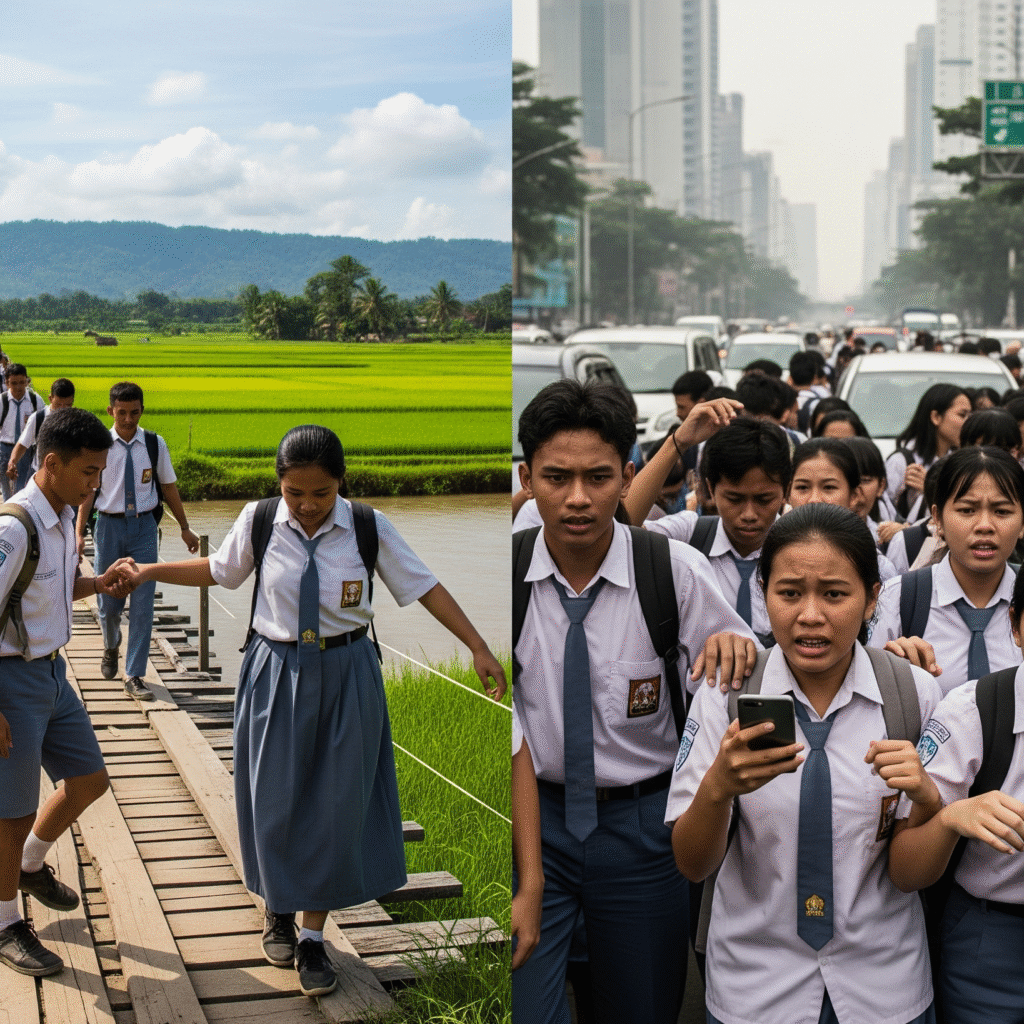Unit 3 – Urban and Rural Challenges
Warm-Up Activities

Activity 1: Brainstorming Challenges
Think about a big city like Jakarta or Bandung and a quiet village in West Java. In the text boxes below, list at least two challenges or problems for each location.
Activity 2: Vocabulary Matching
To understand today’s texts, we need to know these words.
Activity 3: Quick Opinion
Which problem do you think is more difficult to solve?
- A) Traffic congestion in cities
- B) Lack of modern facilities in villages
The Detail Detective: Scanning for Specific Information
Good readers use different strategies. Last week we learned about finding the main idea (gist). To do that, we skim (read quickly for a general overview) the passage thoroughly.
Today, we learn a new skill: scanning. Scanning is when you search for a specific piece of information, like a name, a date, or a reason. You don’t read every word.
Skimming vs. Scanning
Skimming is like looking at a movie poster to see what it’s about.
Scanning is like looking for your friend’s name on a list of movie credits. You ignore everything else until you find the name.
How to Scan:
- Read the question first. Understand what you are looking for.
- Identify keywords in the question (e.g., “reason,” “problem,” “in cities”).
- Move your eyes quickly over the text. Don’t read it word-for-word. Search only for your keywords.
- Stop and read carefully when you find a keyword. The sentence around it usually contains the answer.
TOEFL Question Types for this Skill:
Factual Information: Asks for a specific detail mentioned in the passage.
Example: “According to paragraph 2, what is one cause of pollution?”
Negative Factual Information: Asks which detail is NOT mentioned. These questions always have “NOT” or “EXCEPT” in capital letters.
Example: “The author mentions all of the following as rural challenges EXCEPT…”
Strategy to face Negative Faction Information: Find the three answers that ARE in the text. The remaining one is your answer.
Skill Practice
Scan the short passage below to answer the questions that follow.
Urban and Rural Difficulties
Both urban and rural areas face unique difficulties that affect the quality of life for their residents. In major cities, traffic congestion is a primary concern. The daily commute can take hours, leading to stress and lost productivity. This heavy traffic is also a major source of air pollution, which can cause health problems. On the other hand, a significant challenge for many rural areas is the limited access to specialized services. While most villages have a local clinic, access to a large hospital with specialists and advanced medical technology often requires a long and difficult journey. This can be dangerous in an emergency.
Read the short passage below and complete the exercises that follow.
Urban and Rural Divides
Both urban and rural areas face unique difficulties that affect the quality of life for their residents. In large cities, overcrowding is a primary concern. With so many people living in a limited space, issues like traffic congestion and high housing costs are common. Furthermore, air and noise pollution from industry and traffic can have negative effects on health. These problems are a daily reality for millions of urban dwellers.
In contrast, rural areas struggle with a different set of challenges. Isolation is often a major issue, as public transportation can be limited, making it difficult to access services like healthcare and higher education. Another significant problem is the lack of diverse job opportunities, which can lead to higher rates of unemployment, especially among young people. While the countryside offers a peaceful environment, its underdeveloped infrastructure can limit progress and convenience for its inhabitants.
A. Multiple-Choice Questions
B. Fill in the Blanks
C. Crossword Puzzle
D. Word Search
You’ve reached the end of the lesson. Click the button below to begin the Evaluation Quiz.